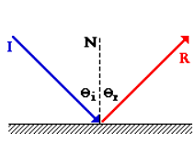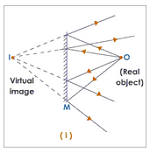
LAWS OF REFLECTION
Light of Class 9
LAWS OF REFLECTION
There are two laws of reflection
The Law of Reflection
Light is known to behave in a very predictable manner. If a ray of light could be observed approaching and reflecting off of a flat mirror, then the behavior of the light as it reflects would follow a predictablelawknown as thelaw of reflection. The diagram below illustrates the law of reflection.
FIRST LAW OF REFLECTION:
According to the first law of reflection, the incident ray, the reflected ray and the normal at the point of incidence all lie in the same plane which is perpendicular to the plane of the reflecting surface.

In the diagram, the ray of light approaching the mirror is known as theincident ray(labeledIin the diagram).The ray of light that leaves the mirror is known as thereflected ray(labeledRin the diagram).At the point of incidence where the ray strikes the mirror, a line can be drawn perpendicular to the surface of the mirror. This line is known as a normal line(labeledNin the diagram). The normal line divides the angle between the incident ray and the reflected ray into two equal angles. The angle between the incident ray and the normal is known as theangle of incidence. The angle between the reflected ray and the normal is known as theangle of reflection. The law of reflection states that when a ray of light reflects off a surface, the angle of incidence is equal to the angle of reflection.
SECOND LAW OF REFLECTION:
According to the second law of reflection, the angle of incidence is always equal to the angle of reflection for small angles.
i.e. ∠i = ∠r
Where ∠i = angle of incidence.
∠r = angle of reflection.
The laws of reflection of light apply to all kinds of mirrors, plane mirrors as well as spherical mirrors.
|
|
A ray of light which is incident normally on a reflecting surface (say a mirror), is reflected back along the same path because the angle of incidence as well as the angle of reflection for such a ray of light are zero. (i.e. ∠ i = ∠ r = 0°.) |
Ex. What happens a ray of light falls normally (or perpendicularly) on the surface of a mirror?
Solution: A ray of light which is incident normally on a mirror, is reflected back along the same path because the angle of incidence as well as angle of reflection for such a ray of light are zero.
MIRROR:
It is a highly polished surface, which is quite smooth the capable of reflecting a good fraction of light from its surface.
Object:
Anything which gives out light rays (either its own or reflected) is called an object.
(i) Real object: All physical objects and light sources are real which either scatter light rays or produces light rays.

(ii) Virtual object: When converging incident rays are incident on eye or an optical device, there is no single point from which light rays actually come. In this case we say the object is virtual.

Related Topics









